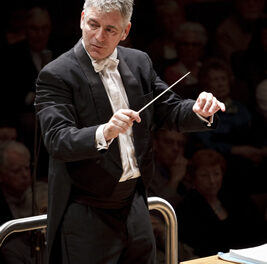The opening of the NC Symphony‘s summer home at Cary’s Regency Park – the Koka Booth Amphitheatre – predated the official launch of CVNC by about a month, but we’ve covered events there virtually from the beginning (and, in prior lives of our founding critics, concerts in the tent that provided some protection for the orchestra before the construction of the present shell). The tally of this journal’s reviews of “Summerfest” programs exceeds 40.* I mention this since the review you are about to read differs in significant ways from all those other ones because, as our state orchestra enters its 10th season in those Town of Cary digs, everything at last seems to have come together: the orchestra is playing wonderfully under its strong artistic leadership, the programs are wide-ranging and appealing, the crowds seem respectful and quiet, the landscaping and garden plantings boost patrons’ spirits, the staff is cheerful and welcoming, the victuals are plentiful and affordable, the parking’s free and not too far away, all things considered – and the sound is better than ever – perhaps better than ever at any al fresco concert ever heard hereabouts. What more could one want?
Well, on the evening of June 4, the weather cooperated, too – after an abysmal week, the skies were clear of everything but vapor trails, the humidity was low, and ever-so-slight breezes kept perspiration handily at bay. Red-vested Red Cross volunteers unobtrusively circulated through the crowd, collecting donations for tornado relief. (Readers may donate at the NCS’ website.) And the concert ended with spectacular fireworks in this particularly attractive setting – it’s easily the best in the entire region for pyrotechnics. Perhaps we should simply say that the rest of the Summerfest concerts are in CVNC‘s calendar and you really owe it to yourself and your family and friends to get up a good-sized group and go check them out.
But if we stopped there we’d shortchange NCS Music Director Grant Llewellyn and the members of the orchestra – mostly regulars, I think, but with some fill-ins – and the evening’s distinguished guest artist, soprano Rhiannon Giddens Laffan, who hails from Greensboro, who has garnered high praise at home and abroad for her captivating and enthralling singing in diverse genres encompassing opera, musical theatre, cabaret, and more, and whose band, The Carolina Chocolate Drops, took a Grammy in February for best traditional folk album. So you take this exceptional singer with her great stage presence and you pair her with a Welsh guy with a gift of gab that makes one think he’s a closet Irishman, you overlay the two with some smooth – and smoothly amplified – orchestral sounds, and the result, on this occasion, was a 90-or-so-minute program formally titled “Around the World in Eighty Minutes” that reflected an eclectic (and musical) world view – Llewellyn’s – a good deal better than a certain blockbuster Mike Todd flick of long ago.
The itinerary embraced music by the NCS’ own Terry Mizesko (a substantial movement from whose Highland Suite served as the overture) to Grainger, Mathias, J.F. Wagner, Offenbach, and Dvořák, and then, in part two, Glière, Paranjoti, Rodgers, J. Gade, and a generous salute to American big bands. Along the way, the solo artist enlivened the proceedings with ever-so-idiomatically rendered tunes made famous in Paris and beyond by Edith Piaf (and impressively enough introduced, too, in French, by Llewellyn), a dazzlingly bravura performance of “Mein Herr Marquis,” from J. Strauss II’s Fledermaus, “Bali Hai,” from South Pacific, a steamy “Brazil” in two impressively distinct parts (with, I think, the stick-waver at the keyboard), and, as an encore, (“Just a few more weary days and then…”) “I’ll Fly Away,” which was would have been hard to top by anything other than those aforementioned fireworks. This vocalist has several voices, or so it would appear – a velvety chest voice, heard to prime advantage in the second Piaf number, and a clear, clean operatic high voice, virtually devoid of diva-esque mannerisms, as heard in the Strauss.
The unusual numbers – or unusual in this setting – were a snippet from Mathias’ Celtic Dances (in the world premiere of which Llewellyn, then a youth orchestra cellist, played), J.F. Wagner’s “Under the Double Eagle March,” and a portion of the Dravidian Suite by Victor Paranjoti (1907-67), music uncovered (or perhaps discovered) by our Music Director in a second-hand shop in London. Although this Suite may have initially been meant for chorus, “Dithyramb” is an attractive bit of Indian ethnic music in Western orchestral garb that suggests some of the crossover pieces (from other lands) played by Stokowski; it would be good to hear the rest of it at some point.
So it was a wonderful – and indubitably memorable – evening. And we can’t move away from it without praising sound technician Fred Brumbach and his company, On Stage Gear. He told me he used 64 microphones – with each of the string instruments individually drawn into the mix. There was no spotlighting here, no apparent gain-riding, no blasting when things reached above forte, no dropping out in quiet passages, no swamping of winds and strings by the brasses. This time, the orchestra sounded like an orchestra in a very decent concert room. Wow! What an innovation – at last!
This show may be heard in Jacksonville on June 5; for details, click here.
Summerfest resumes June 11, in Cary; for details, see our calendar.
*Please note that we have restored to our archives all reviews and previews dating back to the summer of 2001, and all are now readily searchable, so coming up with article counts – or references to your favorite artist or masterwork – is now very quick and easy – just see the “Advanced Article Search Options” and you’re on your way!











